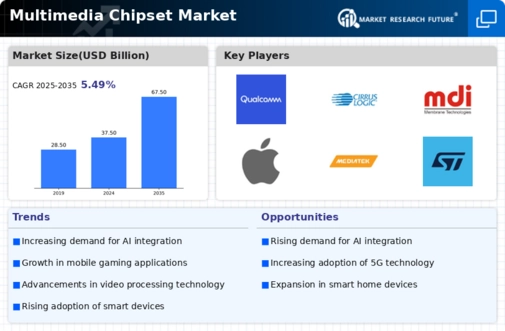Top Industry Leaders in the Multimedia Chipset Market

Competitive Landscape of Multimedia Chipset Market
The multimedia chipset market, the hidden engine powering our digital experiences, is experiencing explosive growth. From smartphones to smart TVs, these tiny silicon brains process, decode, and enhance the audio and video content we consume daily. This dynamic landscape is teeming with established giants and nimble startups, all vying to dominate the market with innovative technologies and strategic maneuvers.
Some of the Multimedia Chipset companies listed below:
- NVIDIA Corporation
- Intel Corporation
- Realtek Semiconductor Corp
- Qualcomm Inc.
- Cirrus Logic Inc.
- Advanced Micro Devices Inc.
- DSP Group, Inc. (U.S.), Apple Inc.
- Broadcom Corporation
- Marvell Technology Group, Limited
Strategies Adopted by Key Players:
- Differentiation: Companies like Apple stand out by vertically integrating hardware and software, creating tightly coupled ecosystems and optimizing performance. Others, like Qualcomm, focus on specific features like enhanced AI capabilities or superior camera processing.
- Collaboration and Partnerships: Strategic partnerships with device manufacturers, software developers, and content providers are crucial for securing market share and reaching target audiences.
- Cost Leadership: Catering to the budget-conscious segment through cost-effective solutions is a key strategy for companies like MediaTek in emerging markets.
- Focus on Sustainability: As environmental concerns intensify, energy-efficient chipsets with lower carbon footprints are becoming increasingly important.
Factors for Market Share Analysis:
- Technology Leadership: Leading with cutting-edge features like ray tracing and AI-powered upscaling drives market share in the high-end segment.
- Integration and Performance: Integrating various multimedia functionalities (graphics, audio, video) into a single chipset simplifies design and improves power efficiency, influencing market share.
- Target Audience: Catering to specific needs of industries like gaming, mobile, or broadcasting with tailored features and pricing strategies plays a crucial role.
- Brand Reputation and Partnerships: A strong brand image and strategic partnerships with OEMs and software developers contribute significantly to market share.
- Cost and Value Proposition: Balancing affordability with performance is key, especially in budget-conscious segments.
New and Emerging Companies:
- Rise of Fabless Chipmakers: Companies are designing chipsets without owning fabrication facilities, reducing costs and increasing agility.
- Focus on AI and Machine Learning: Integration of AI into multimedia processing promises enhanced performance and user experiences.
- Growth of Wearable Electronics: The demand for chipsets for smartwatches, fitness trackers, and AR/VR devices is creating new opportunities.
- Regional Expansion: Emerging markets are witnessing rapid growth, attracting new players and forcing established companies to adapt.
Latest Company Updates:
NVIDIA Corporation:
- October 20, 2023: Launch of GeForce RTX 40 Series GPUs featuring the Ada Lovelace architecture, offering 2x faster performance than the RTX 3090 at the same power level.
- December 6, 2023: Announcement of Project Gauguin, a technology capable of generating ultra-realistic 3D worlds in real-time using AI, with potential applications for animation, game development, and VR experiences.
Intel Corporation:
- November 16, 2023: Unveiling of 14th Gen Intel Core Processors (Alder Lake Refresh), delivering improved performance and efficiency compared to predecessors, with enhanced integrated graphics for better multimedia capabilities.
- December 12, 2023: Announcement of a strategic partnership with MediaTek, combining Intel's CPU leadership with MediaTek's 5G and AI expertise for smart connected devices and the Internet of Things (IoT).
